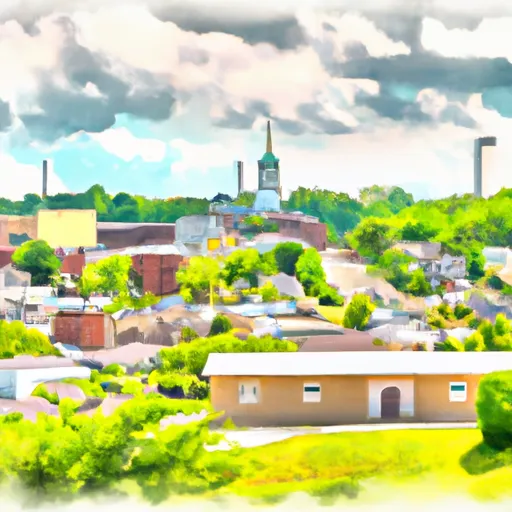-
 Snoflo Premium
Snoflo Premium
Get unlimited access to all our content
With no Ad interruptions! - Start Your Free Trial Login with existing account
Hebron
Eden Index
Climate
8.2
•
Recreation
6.3
•
Community
4.0
•
Safeguard
6.5/10

Hebron, Kentucky is located in the northern part of the state, just minutes from the Ohio border. The climate in Hebron is characterized by hot summers and cold winters, with an average annual temperature of 54°F. The area receives an average of 44 inches of rain per year and experiences occasional flooding due to its proximity to the Ohio River. Outdoor recreation opportunities in Hebron include hiking and biking at the Boone County Arboretum, fishing at nearby Gunpowder Creek, and golfing at the world-renowned Golf Club of Kentucky. Additionally, the city is home to the Cincinnati/Northern Kentucky International Airport, making it a convenient location for travelers.
What is the Eden Index?
The Snoflo Eden Index serves as a comprehensive rating system for regions, evaluating their desirability through a holistic assessment of climate health, outdoor recreation opportunities, and natural disaster risk, acknowledging the profound impact of these factors on livability and well-being.
Climate Health Indicator (CHI): 8.2
Hebron receives approximately
1156mm of rain per year,
with humidity levels near 81%
and air temperatures averaging around
12°C.
Hebron has a plant hardyness factor of
6, meaning
plants and agriculture in this region thrive during a short period during spring and early summer. Most
plants will die off during the colder winter months.
By considering the ideal temperature range, reliable water supplies, clean air, and stable seasonal rain or snowpacks, the Climate Health Indicator (CHI) underscores the significance of a healthy climate as the foundation for quality living.
A healthy climate is paramount for ensuring a high quality of life and livability in a region, fostering both physical well-being and environmental harmony. This can be characterized by ideal temperatures, reliable access to water supplies, clean air, and consistent seasonal rain or snowpacks.
Weather Forecast
Streamflow Conditions
Middle Ohio-Little Miami
Area Rivers
Middle Ohio-Little Miami
Snowpack Depths
Middle Ohio-Little Miami
Reservoir Storage Capacity
Middle Ohio-Little Miami
Groundwater Levels
Recreational Opportunity Index (ROI): 6.3
The Recreational Opportunity Index (ROI) recognizes the value of outdoor recreational options, such as parks, hiking trails, camping sites, and fishing spots, while acknowledging that climate plays a pivotal role in ensuring the comfort and consistency of these experiences.
Access to outdoor recreational opportunities, encompassing activities such as parks, hiking, camping, and fishing, is crucial for overall well-being, and the climate plays a pivotal role in enabling and enhancing these experiences, ensuring that individuals can engage in nature-based activities comfortably and consistently.
Camping Areas
| Campground | Campsites | Reservations | Toilets | Showers | Elevation |
|---|---|---|---|---|---|
| Kentucky Horse Park Campground | 270 | 880 ft | |||
| Alum Ford - Big South Fork Area | None | 761 ft | |||
| Cumberland Point - Lake Cumberland | 30 | 906 ft | |||
| Boat Ramp - Elmer Davis Lake - DFWR | None | 735 ft | |||
| Fall Creek - Lake Cumberland | 10 | 843 ft | |||
| Waitsboro - Lake Cumberland | 25 | 763 ft | |||
| Bullock Pen Lake Ramp - DFWR | None | 774 ft | |||
| Boltz Lake Ramp - DFWR | None | 842 ft | |||
| General Burnside State Park | 95 | 872 ft | |||
| Big Bone Lick State Park | 60 | 496 ft |
Nearby Ski Areas
Catastrophe Safeguard Index (CSI):
The Catastrophe Safeguard Index (CSI) recognizes that natural disaster risk, encompassing floods, fires, hurricanes, and tornadoes, can drastically affect safety and the overall appeal of an area.
The level of natural disaster risk in a region significantly affects safety and the overall livability, with climate change amplifying these risks by potentially increasing the frequency and intensity of events like floods, fires, hurricanes, and tornadoes, thereby posing substantial challenges to community resilience and well-being.
Community Resilience Indicator (CRI): 4.0
The Community Resilience Indicator (CRI) recognizes that education, healthcare, and socioeconomics are crucial to the well-being of a region. The CRI acknowledges the profound impact of these elements on residents' overall quality of life. By evaluating educational resources, healthcare accessibility, and economic inclusivity, the index captures the essential aspects that contribute to a thriving community, fostering resident satisfaction, equity, and social cohesion.

